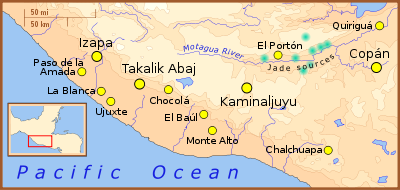
Ujuxte
Encyclopedia

Mesoamerican chronology
Mesoamerican chronology divides the history of pre-Columbian Mesoamerica into several periods: the Paleo-Indian , the Archaic , the Preclassic , the Classic , and the Postclassic...
site to be discovered on the Guatemalan Pacific coast. It is in the Retalhuleu Department, in western Guatemala
Guatemala
Guatemala is a country in Central America bordered by Mexico to the north and west, the Pacific Ocean to the southwest, Belize to the northeast, the Caribbean to the east, and Honduras and El Salvador to the southeast...
.
Site
The site includes approximately two hundred earthen mounds spread over some 200 hectares (494 acres) of farmland. Located 12 kilometres (7.5 mi) from the Pacific Ocean, the site is of particular importance because there has been no Preclassic site of comparable size and period of occupation excavated in this region. The site was probably founded about 1200 BC and was occupied until about AD 200, when it was apparently abandoned in favor of Takalik AbajTakalik Abaj
Tak'alik Ab'aj is a pre-Columbian archaeological site in Guatemala; it was formerly known as Abaj Takalik; its ancient name may have been Kooja. It is one of several Mesoamerican sites with both Olmec and Maya features...
, to the east.
The two largest mounds are the focus of the central plaza which is oriented to the raising of the sun on the mornings of the spring and fall equinoxes. Mound 1 is 20 metres (65.6 ft) in height and Mound 2 is 16 metres (52.5 ft) high. The plaza also consists of an early ballcourt
Mesoamerican ballgame
The Mesoamerican ballgame or Tlatchtli in Náhuatl was a sport with ritual associations played since 1,000 B.C. by the pre-Columbian peoples of Ancient Mexico and Central America...
formed by Mounds 3 and 4, each over 7 metres (23 ft) tall. Early occupation of the site was widespread, covering over 4 square kilometres (1.5 sq mi). Later growth filled in the open spaces, forming the current dense pattern of mounds seen today.
The central plaza appears to have a celestial alignment that coincides with the rise and fall of the Pleiades
Pleiades (star cluster)
In astronomy, the Pleiades, or Seven Sisters , is an open star cluster containing middle-aged hot B-type stars located in the constellation of Taurus. It is among the nearest star clusters to Earth and is the cluster most obvious to the naked eye in the night sky...
. Also, on the summer solstice the sun rises from behind the Tajumulco
Tajumulco
Tajumulco is a municipality in the San Marcos department of Guatemala....
volcano on the eastern horizon, in a line directly over the plaza. The celestial alignment is only maintained in the central plaza, which is most likely the ceremonial center. The outer edges of the site, however, show no alignment, possibly representing a residential area. Several regional sites, contemporaneous and in proximity to Ujuxte, are smaller copies and appear to be secondary centers to Ujuxte, which indicate its importance and domination in the region.
Study
The Ujuxte Archaeological Project was begun, by E. M. Shook and the Universidad de San Carlos de GuatemalaUniversidad de San Carlos de Guatemala
The Universidad de San Carlos de Guatemala It is the biggest and oldest university of Guatemala, also it is the fourth founded in the Americas....
, in order to amplify data on the Early and Middle Preclassic periods along the Pacific coastal plain of Guatemala and to investigate the key questions of regional prehistory following the collapse of La Blanca
La Blanca
La Blanca is a pre-Columbian Mesoamerican archaeological site in present-day Retalhuleu Department, western Guatemala. It has an occupation dating predominantly from the Middle Preclassic period of Mesoamerican chronology, and at its peak was one of the largest known Mesoamerican sites of that era...
. The research at Ujuxte is centered on the study of the growth and collapse of early states in the region. One nearby secondary center, Chiquirines
Chiquirines
Chiquirines is an ancient Pre-Columbian archaeological site, located in the modern day Retalhuleu Department, Guatemala. It is located near the major Preclassic Period site of Ujuxte and is considered to be a satellite of that city and contemporary with it...
, had a focal grouping of mounds that replicated the principal grouping at Ujuxte.

